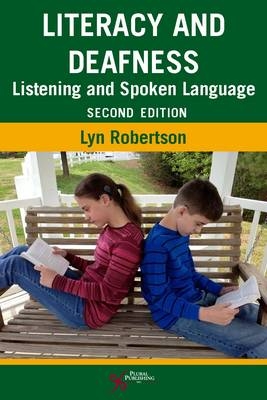
Literacy and Deafness
Plural Publishing Inc (Verlag)
978-1-59756-557-8 (ISBN)
- Titel z.Zt. nicht lieferbar
- Versandkostenfrei
- Auch auf Rechnung
- Artikel merken
Lyn Robertson teaches in the Department of Education of Denison University, a liberal arts college in Granville, Ohio. She began her career teaching seventh grade English where she discovered students achieving at low levels in reading and writing. This led her to extensive study of literacy, particularly within linguistic, cognitive, and social frameworks. Robertson has taught reading and about reading to people from preschool to adulthood. The mother of a daughter with severe-to-profound hearing loss, she has authored one book, Literacy Learning for Children Who Are Deaf or Hard of Hearing, and articles about listening and reading. She also teaches in the A.G. Bell First Years program and serves on the Alexander Graham Bell Association for the Deaf and Hard of Hearing Academy for Listening and Spoken Language.
A History of Reading Achievement in People with Hearing Loss Introduction A Review of Selected Studies Higher Scores and Spoken Language Conclusion Literacy Theories Introduction Theorizing About Reading Definitions of Reading Word Identification Comprehension An Interactive Theory Many Disciplines Study Reading Conclusion Technology and Listening, by Carol Flexer, Ph.D., LSLS CERT. AVT Introduction Neurologic Basis of Listening and Literacy Practice, Practice, Practice Computer Analogy for Understanding Amplification Technology Overview of Amplification Technologies - A New Context Hearing Aids/Instruments Personal-Worn FM Technology Sound Field Technology Cochlear Implants Auditory Feedback Loop Distance Hearing/Incidental Learning Functional Definitions: Hearing-Impaired, Hard-of-Hearing, and "Deaf" Conclusion Spoken Language Introduction Learning the Sounds of a Spoken Language Beyond the Sounds of Language What About Bridging from American Sign Language? Learning Spoken Language Two Extended Studies of Children's Language Learning and Later Academic Achievement "Advantaged" and "Disadvantaged" Parents Conclusion Hearing, Listening, and Literacy Introduction Phonological Awareness Phonological Processing Capabilities The Auditory-Verbal Approach Principles of Listening and Spoken Language Specialist Auditory-Verbal Therapy (LSLS Cert. AVT) Principles of Listening and Spoken Language Specialist Auditory-Verbal Education (LSLS Cert. AVEd) Conclusion Issues in Child Development, by Gina Dow, Ph.D. Introduction Sensitivity in the Caregiving Relationship Part I: Early Identification Attunement and Early Identification of Hearing Loss Early Identification and Intervention - How Early Is Early Enough? Early Identification in the United States How Screening Is Done From Screening to Identification to Intervention How Does Early Identification Contribute to Good Developmental Outcomes? Development of Theory of Mind Concluding Remarks and Recommendations Part II: Typical Development - Birth to Age Five Learning to Read Introduction Constructivism in Action Shared Book Reading Establishing a Rich Literacy Environment Reading Comprehension and the Child Practical Ideas for Helping Children Learn to Read Conclusion Learning to Write Introduction Writing and the Auditory-Verbal Approach A Word About Development Practical Ideas for Helping Children Learn to Write Conclusion Proceeding Through School Introduction The "Fourth-Grade Slump" Comprehension Growth Academically Successful Young Adults with Hearing Loss Conclusion Parents, Therapists, and Teachers Working Together Introduction Emotional Connectedness and a Team Approach IDEA and IEPs Using Mediation and Mediation Skills Practical Ways for the Team to Communicate Conclusion English Language Learners and Bilingualism Introduction Can Children with Hearing Loss Learn More Than One Spoken Language? Learning to Read in the First Language First Hearing or Deaf, Language Learning Is Language Learning Conclusion Assessment Issues and Approaches Introduction Norm-Referenced Standardized Tests Criterion-Referenced Tests The Relative Value of Norm-Referenced and Criterion-Referenced Tests Practical Reading Assessments for Teachers to Use Conclusion Promising Literacy Programs Introduction Four General Suggestions Before, During, and After Reading Specific Steps Reading and Writing as Thinking: The Basis of Good Programs in Reading Conclusion Educational Settings for Children with Hearing Loss Introduction The Optimum Placement What if the Optimum Is Not Possible? Schooling Is Not the Only Source of Education Some Thoughts About the Role Learning Music Can Play in Learning Language A Letter to a Mainstream Classroom Teacher Conclusion Thoughts From Two Founders of the Auditory-Verbal Approach Introduction Foreword, 1990, by Daniel Ling, Ph.D. An Auditory-Verbal Retrospective: A Personal Account of Individual Effort and International Organization, 1989, by Helen Hulick Beebe, CCC/SP Appendix A. Knowledge Needed by Listening and Spoken Language Specialists Appendix B. Listening and Spoken Language Specialist (LSLS) Domains Addressed in This Book Appendix C. Description, Approaches, and Practice of Listening and Spoken Language Specialists Index
| Erscheint lt. Verlag | 1.10.2013 |
|---|---|
| Zusatzinfo | b/w illustrations |
| Verlagsort | San Diego |
| Sprache | englisch |
| Maße | 152 x 229 mm |
| Gewicht | 522 g |
| Themenwelt | Schulbuch / Wörterbuch ► Wörterbuch / Fremdsprachen |
| Geisteswissenschaften ► Sprach- / Literaturwissenschaft ► Sprachwissenschaft | |
| Medizin / Pharmazie ► Gesundheitsfachberufe ► Logopädie | |
| ISBN-10 | 1-59756-557-1 / 1597565571 |
| ISBN-13 | 978-1-59756-557-8 / 9781597565578 |
| Zustand | Neuware |
| Haben Sie eine Frage zum Produkt? |
aus dem Bereich


